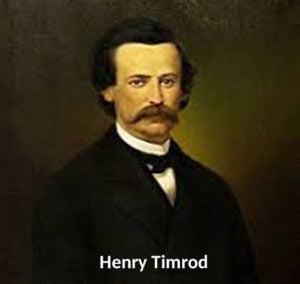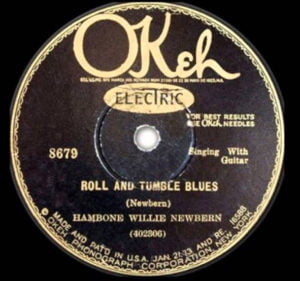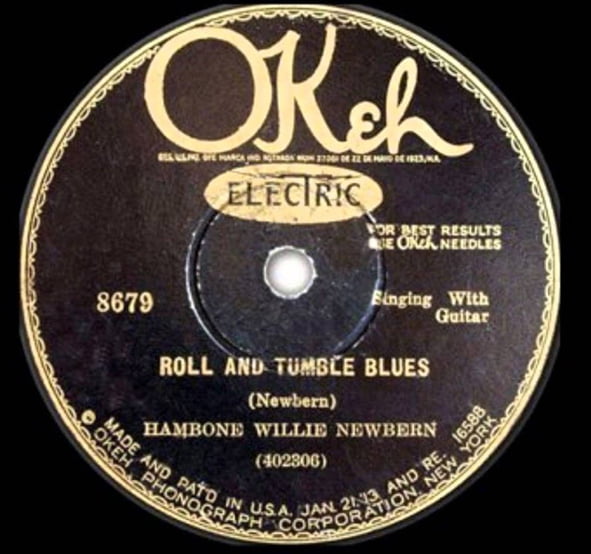..I’ve been conjuring up all these long dead souls from their crumblin’ tombs…

And so the thoughts revolve around the poet’s mind. He’s been up all night. Sleep has been impossible. He sits on the edge of the bed, watching the young woman sleeping, her luxuriant dark hair tossed across her face. He leans closer, brushes a few strands away. He can smell the light traces of perfume, drawing him closer and closer. He is tempted to kiss her neck, just at that spot that makes her shiver. But he knows he must not wake her. He draws back, walks over to the window, and watches the first rays of dawn rising over the tenements downtown. His notebook is on the table. But still the words will not come to him. So he closes his eyes. Begins to tap his feet. Maybe if he concentrates hard enough he will begin to hear some music…
Rollin’ And Tumblin’ is the first of three blues songs on Modern Times which are clearly based on established models. Since the album was released, blues scholars and Dylan enthusiasts have been feverishly digging around to find the sources, not only of these three songs, but of many of the lines from the other songs on the album. We now know, for instance, that a number of lines – scattered throughout the album – have been ‘lifted’ from the obscure American Civil War poet Henry Timrod (‘Timrod’, we are told, is also ‘nearly’ an anagram of ‘Modern Times!). Just as with the case of the expropriation of phrases from a Japanese novel in Love And Theft’s Floater, the ‘Timrod’ connection has provided column inches in national newspapers. The question has arisen – yet again – whether Dylan is a ‘plagiarist’. Those who know Dylan’s work well can only smile at this. From his earliest days, his songs have been ‘developed’ from other songs. Almost all the songs on his breakthrough album Freewheelin‘ (1963) took their melodies and basic structure from traditional folk songs – Girl Of The North Country from Scarborough Fair, Bob Dylan’s Dream from Lord Franklin, A Hard Rain’s A-Gonna Fall from Lord Randall, Masters of War from Nottamun Town and so on. Such instances can be found throughout Dylan’s career. In a recent interview Dylan revealed that his songwriting generally begins with him playing old folk, blues or country tunes to himself and then gradually changing the words arounds. It is a method not uncommon amongst songwriters in his field. Blues singers in particular have always adapted and developed existing songs to their own ends. In Dylan’s case, this methodology gives his work a particular type of resonance – one song refers to another, or quite possibly several other songs – making the work rooted in cultural traditions and enriching the song’s poetic content by suggesting that it somehow ‘contains’ the work of previous poet/songwriters.

Since the early 1990s, when Dylan’s transformation into the renewed artist of today began, he has turned this method of anchoring his songs within the folk and blues traditions into a kind of modus operandi. Seven years passed between the release of the patchy Under The Red Sky (1990) and the brilliant resurgence of Time Out Of Mind (1997), during which time Dylan engaged in a thorough exploration of the art of songwriting itself, the ultimate aim of which was to renew his own sources of inspiration. As well as the two albums of traditional songs Good As I Been To You (1992) and World Gone Wrong (1994) he performed literally hundreds of ‘covers’ on his Never Ending Tour, ranging from sea shanties to the work of contemporary songwriters. Very often these cover versions were the highlights of the gigs. At times he seemed to be merely ‘churning out’ his old hits while his own interest seemed to be most focused on this exhaustive exploration of his ‘roots’. As a result Time Out Of Mind was steeped in quotation from and reference to a plethora of folk and blues classics. Throughout his succeeding work, Dylan has continued to reference the huge body of work that appears to ‘stand behind’ his new songs. The majority of this material originated in the pre-rock and roll decades, from the 1920s to the early 1950s. Over the last year he’s been treating listeners to his fabulously quirky selection of tunes from this era on his Theme Time Radio Hour show.
At the heart of this ‘postmodern’ preoccupation with ‘pre-modern’ times lies Dylan’s devotion to the poetry and mystery of the blues. This has been a lifelong preoccupation. As early as 1963 – in the Freewheelin’ sleevenotes – Dylan declared that his ambition was to learn to …carry myself like Big Joe Williams… Very many of his albums were punctuated by his exercises in the idiom – from Highway 61’s It Takes A Lot To Laugh to Blood On The Tracks’ Meet Me In The Morning. His epochal summation of the ethos of the blues in 1983’s Blind Willie McTell was a kind of humble act of supplication to the timeless relevance of the form (although at the time, caught in the grip of artistic and spiritual uncertainty, he lacked the confidence to release it). Having essayed the form in Love And Theft’s Lonesome Day Blues, Cry Awhile and Honest With Me, using the blues as a loose structure for that album’s more scatalogical approach, in the more direct Modern Times he intersperses his meditational ballads with pure evocations of the form. Rollin’ and Tumblin’ is built squarely on the version of the song made famous by Muddy Waters and since recorded by a number of prominent rock/blues acts such as Canned Heat, Eric Clapton, Johnny Winter and Dr. Feelgood. Waters’ version is a development of the earliest known version, Roll and Tumble Blues, recorded by Hambone Willie Newbern in 1929. Robert Johnson adapted parts of the song for his apocalyptic blues If I Had Possession Over Judgement Day. The real ‘author’ of the song is unknown.

Rollin and Tumblin’ uses the archetypal twelve-bar blues form, with two repeated lines followed by a rhyming line. Dylan’s version preserves the basis of the first verse but extends the song to eleven verses. He throws in various phrases from other blues songs: …I must have bet my money wrong… …Let’s go down to the Greenwood Glen… …My sufferin’ heart is always on the line… and more. The song is a kind of ‘patchwork quilt’ of references, a presentation of key blues imagery. As such it can be regarded as a kind of ‘dissertation’ on the blues itself, focused as it is on the archetypal ‘woke up this morning/my baby left me’ theme . The band’s playing is relaxed but the performance is full of energy, with Dylan twisting and turning the words around to bring out their full ambiguity. As with the other songs on Modern Times, however, the writing is very precise. The blues is a specific form of expression which has its own symbolism, particularly centred around sexual matters. As a poetic form it often works on several levels of ambiguity. Sex is conveyed in all sorts of colourful ways – references to milk, butter and cows for example are normally related to women’s sexuality. But the really skilful blues performer can stretch the ambiguity further, so that the sexual references may symbolise some deeper struggle. The ability to tease such levels of meaning out of a song depends greatly on the way the singer phrases the words. And Dylan, of course, is a master of phrasing, having developed the ability to alter the meanings of songs by varying the way he times his pronunciation. This is the lesson he has learned from the blues masters.
Rollin’ and Tumblin’ is a tribute to those masters. Though it appears to be a song about a woman, its real subject is the how a blues song is formulated. And, through the subtleties of Dylan’s phrasing, it also reflects on the process of composition itself, and of an artist’s struggle to find inspiration. On those prophetic Freewheelin’ sleeve notes Dylan also stresses the understanding he had of this process even at such a tender age. Blues singers, he tells us, sing not just to express their pain but in order to make themselves feel better. The performance of Rolling And Tumbling, although it begins by expressing a soul in turmoil, is sprightly, uptempo, full of joy. He stretches out the word …cried… in the first two lines, lingering on the syllables, as if …I cried the whole night long… is celebratory rather than depressing. The last line of the verse changes the original’s morally confused …I couldn’t tell right from wrong… to the more equivocal …I must have bet my money wrong… In the next verse, after the standard …I got troubles so hard, I can’t stand the strain… he spits out the extraordinary …some lazy slut has charmed away my brains… The (rather offensive) word ‘slut’ sees the singer adopting the hard-drinking, hard-womanising persona that so many blues singers hide behind – he insults the woman here but soon we see how desperate she has made him. The last part of the line suggests that the woman’s wiles have somehow weakened his resolve, or taken away his creative focus.
The next few verses alternate between blues cliches and clever, knowing asides which give us some insight into the fact that the singer’s macho stance is merely a front he’s created to hide the fact that the woman has clearly twisted him round her little finger. The self deprecating …I ain’t nobody’s house boy, I ain’t nobody’s well trained maid…almost makes the whole situation farcical. We get two particularly ironically funny lines, delivered in Dylan’s best deadpan tone: …this woman so crazy…he tells us …I ain’t gonna touch another one for years… and then, even more self-mockingly, ..ain’t nothing so depressing as trying to satisfy this woman of mine… The phrasing, while cramming the words into the metre, is immaculate. The song becomes a little darker, though the undiminished fervour of the performance seems to belie this. The singer returns to the classic blues refrain: …Well I got up this morning/Saw the rising sun return…Then he sneers …sooner or later/You too shall burn… as if wishing for revenge. He becomes even gloomier, retreating from morning to night: …the night’s filled with shadows/the years are filled with early doom…which he rhymes (in another miracle of phrasing) with perhaps the song’s key line: …I’ve been conjurin’ up all these long dead souls from their crumblin’ tombs… In order to come to terms with this woman draining away his vital energies, sapping his inspiration, he has had to ‘conjour up’ the ghosts of Muddy Waters, Robert Johnson, Hambone Willie and all. Dylan delivers the line with relish, twirling his Vincent Price moustache…
Finally he makes a plea for forgiveness, suggesting to the woman that they …forgive each other… and, as a celebration …go down to the Greenwood Glen… (Not, as some have rather comically surmised, a ‘Robin Hood’ reference but an allusion to the black district of Tulsa, Oklahoma, an important centre for jazz and blues in the prewar era). The last verse repeats the first, changing the last few words with what sounds, at first, like a typical ‘signing off’ line in a blues song: …I think I must be traveling on…In fact Dylan sings …traveling wrong… a line which echoes …bet my money wrong… showing that the singer has realised that his approach to his problem with his woman, or his creative problem, has been mistaken. After this clear resolution the track ends abruptly. In Rollin’ and Tumblin’ the blues is used as a metaphor for the artist’s struggle with the creative imagination. This is conveyed through the song’s confident, witty execution. Never does Dylan sound the least bit miserable. In fact, the tone of the song, despite its comic asides, is triumphant. A lesson has been learned. The blues, when correctly applied, is powerful medicine. And Dylan has swallowed a good dose here.
A different version of this text appears in DETERMINED TO STAND: THE REINVENTION OF BOB DYLAN
DYLAN LINKS
DAILY DYLAN NEWS at the wonderful EXPECTING RAIN
THE BOB DYLAN PROJECT- COMPREHENSIVE LISTINGS
STILL ON THE ROAD – ALL DYLAN’S GIGS
THE CAMBRIDGE BOB DYLAN SOCIETY



Leave a Reply